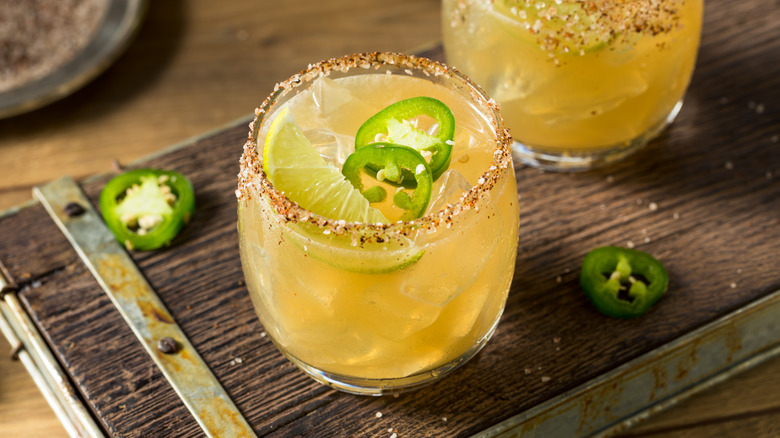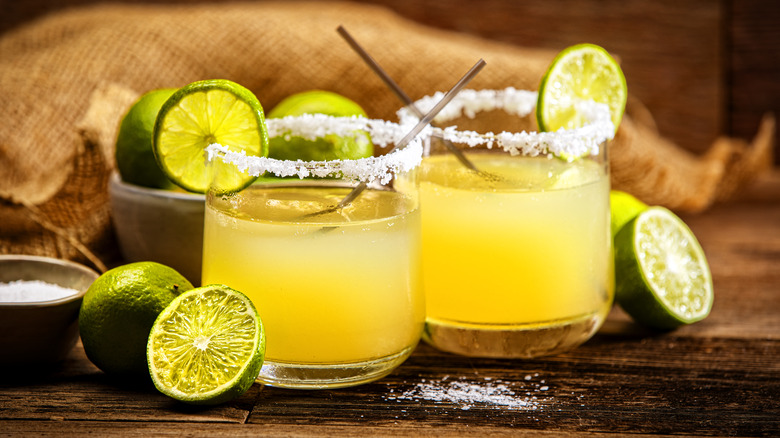Bobby Flay's Major No-No When It Comes To Margaritas
No margarita should be considered complete without a salted rim on the glass. It not only adds some much-welcome visual flair to this iconic drink, but cuts through the bitter citrus flavors of the lime juice and orange liqueur. There are many things you should keep in mind while crafting the perfect salt rim, and one of the hard facts is that not just any salt will do, as world-renowned chef Bobby Flay knows. He cautions home cooks to never use iodized table salt on their margs.
This is the type of fine salt that almost everyone has in their kitchen, so it's certainly convenient to use. But when it's time to garnish a margarita glass, put that cylindrical container with the easy-pour spout away. Because of its small grain size, iodized salt has a tendency to form into unsavory-looking lumps, so it won't be evenly distributed on the rim. Smaller salt crystals also equal more saltiness per tablespoon, creating a briny-tasting, undrinkable cocktail. Some folks are also able to detect the flavor of iodine, which is usually described as iron-like and not pleasant.
Instead, Flay recommends using a salt with larger grains, such as kosher salt. The bigger pieces are not only less likely to clump, but won't melt as quickly upon contact with the lime juice or water you use to wet the rim. Flaky or coarse salt also works for margaritas, but it can vary wildly in crystal size, and therefore won't create a very even rim.
For a better margarita rim, reach for different garnishes
If you want to switch up the flavors of your margarita rim a bit, feel free to use different types of (coarse) salt. Flavored salts, from rosemary to chili to even vanilla, are commonplace at most grocery stores nowadays, and can bring a variety of sweet, spicy, and even acidic undertones to this tasty tipple. For a purely cosmetic change, use pink Himalayan salt — it pretty much tastes like plain kosher salt, but has a pink hue that pairs wonderfully with the colors of a watermelon or strawberry margarita.
You also don't have to only use salt to rim a margarita glass. For example, a sugar garnish can really make the sweetness of a fruity or chocolate margarita pop, while a pinch of spicy Tajín seasoning can really bring out the flavors of a tangy mangonada. Bobby Flay personally enjoys mixing a bit of paprika with salt to garnish his sangria-margarita hybrid (aka sangrita).
Any powder-like ingredient in your pantry can be mixed with salt or sugar to rim your glass, but you want to think carefully about how the flavors will interact. Some seasonings, such as cayenne or garam masala, are incredibly potent on their own and won't be diluted much by the salt, so exercise some caution before reaching for your spice rack.
Other tips for the best margaritas
When you're ready to salt your margarita glass, don't make the mistake of coating the interior of the cup. This will cause the garnish to melt into your cocktail, throwing its flavors off-balance and make the drink taste like sea water. Instead, you'll want to rub the outer rim only with some lime juice, then roll it into your dish of salt at a 45-degree angle. This way, the salt will only stick to the exterior of the glass, leaving the interior pristine.
The salt isn't the only part of the rim that can be customized. Feel free to use a liquid that's not lime juice or water to create a moist surface for the salt to stick to. Lemon juice, sweet syrups, and even spicy chamoy can add any unexpected hint of flavor as the salt dissolves.
On that note, lime juice shouldn't be the only citrus you use for the margs themselves, either. A classic recipe may already be perfect for many, but citrus fans ought to try a squeeze of grapefruit or orange to bring some tart complexity to the drink. The iconic Ina Garten also likes to add lemon juice to her margaritas. Your marg will a have hint of extra-fruity flair that's as refreshing as a lemonade, without distracting too much from the bitterness of the lime juice.



